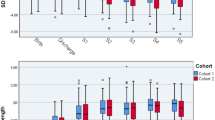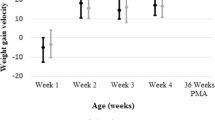Abstract
Early enteral nutrition improves growth of extremely low birth weight infants, but growth curves beyond 30 days of life are lacking for such infants receiving early enteral nutrition. Based on the data of all infants born in a 4-year interval with a birth weight <1000 g and surviving for >56 days, we calculated growth rates and weight gain over 120 postnatal days. Infants with major congenital anomalies or necrotising enterocolitis were excluded. Daily weight, weekly length, head circumference and nutritional data were collected until discharge or for maximal 120 days. Curves were calculated in 100 g birth weight intervals, and separately for appropriate for gestational age (AGA) and small for gestational age (SGA) infants. Data were available from 163 infants (birth weight 768 g ± 153 g; gestational age 26.8±1.8 weeks; mean ± SD) including 55 SGA infants (33.7%). Full enteral feeding was achieved at day 21.7 (±10.4). After 12.8% (±6.6%) maximal postnatal weight loss at day 7.5 (±3.0), birth weight was regained at 14.6 (±6.0) days. Mean overall weight gain was 15 g/kg per day with a significantly higher weight gain for SGA than for AGA infants ( P <0.05). Conclusion:Our early fed infants achieved better weight gain than those recently published receiving late enteral nutrition, but nevertheless fell below the 10th percentile of intrauterine curves. Which postnatal growth is ideal for extremely low birth weight infants infants is unclear. Our growth curves should not be taken as reference curves of a “normal population” but may help to identify infants with growth failure.






Similar content being viewed by others
Abbreviations
- AGA :
-
appropriate for gestational age
- ELBW :
-
extremely low birth weight
- NEC :
-
necrotising enterocolitis
- SGA :
-
small for gestational age
References
American Academy of Pediatrics (1985) Committee on Nutrition: nutritional needs of low-birth weight infants. Pediatrics 75: 976–986
Brosius KK, Ritter DA, Kenny JD (1984) Postnatal growth curve of the infant with extremely low birth weight who was fed enterally. Pediatrics 74: 778–782
Cooke RJ, Ford A, Werkman S, Conner C, Watson D (1993) Postnatal growth in infants born between 700 and 1,500 g. J Pediatr Gastroenterol Nutr 16: 130–135
Dancis J, O’Connell JR, Holt LEJ (1948) A grid for recording the weight of premature infants. J Pediatr 33: 570–572
Ehrenkranz RA, Younes N, Lemons JA, Fanaroff AA, Donovan EF, Wright LL, Katsikiotis V, Tyson JE, Oh W, Shankaran S, Bauer CR, Korones SB, Stoll BJ, Stevenson DK, Papile L-A (1999) Longitudinal growth of hospitalized very low birth infants. Pediatrics 104: 280–289
Fenton TR, McMillan DD, Sauve RS (1990) Nutrition and growth analysis of very low birth weight infants. Pediatrics 86: 378–383
O’Connor DL, Jacobs J, Hall R, Adamkin D, Auestad N, Castillo M, Connor WE, Connor SL, Fitzgerald K, Groh-Wargo S, Hartmann EE, Janowsky J, Lucas A, Margeson D, Mena P, Neuringer M, Ross G, Singer L, Stephenson T, Szabo J, Zemon V (2003) Growth and development of premature infants fed predominantly human milk, predominantly premature infant formula, or a combination of human milk and premature formula. J Pediatr Gastroenterol Nutr 37: 437–446
Pauls J, Bauer K, Versmold H (1998) Postnatal body weight curves for infants below 1000 g birth weight receiving early enteral and parenteral nutrition. Eur J Pediatr 157: 416–421
Pohlandt F (1994) Prevention of postnatal bone demineralization in very low birth weight infants by individually monitored supplementation with calcium and phosphorus. Pediatr Res 1: 125–129
Shaffer SG, Quimiro CL, Anderson JV, Hall RT (1987) Postnatal weight changes in low birth weight infants. Pediatrics 79: 702–705
Singhal A, Fewtrell M, Cole TJ, Lucas A (2003) Low nutrient intake and early growth for later insulin resistance in adolescents born preterm. Lancet 361: 1089–1097
Steward DK, Pridham KF (2002) Growth patterns of extremely low birth weight hospitalized preterm infants. JOGNN 31: 57–65
Voigt M, Schneider KTM, Jaehrig K (1996) Analyse des Geburtengutes des Jahrgangs 1992 der Bundesrepublik Deutschland. Geburtsh u Frauenheilk 56: 550–558
Wright K, Dawson JP, Fallis D, Vogt E, Lorch V (1993) New postnatal growth grids for very low birth weight infants. Pediatrics 91: 922–926
Acknowledgement
We are grateful to Prof. Reinhard Roos for allowing us to include infants on his intensive care unit.
Author information
Authors and Affiliations
Corresponding author
Additional information
These data are part of the doctoral thesis of Mareike Diekmann. The study was partly supported by Nestlé
Rights and permissions
About this article
Cite this article
Diekmann, M., Genzel-Boroviczény, O., Zoppelli, L. et al. Postnatal growth curves for extremely low birth weight infants with early enteral nutrition. Eur J Pediatr 164, 714–723 (2005). https://doi.org/10.1007/s00431-005-1756-2
Received:
Revised:
Accepted:
Published:
Issue Date:
DOI: https://doi.org/10.1007/s00431-005-1756-2




